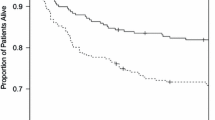Abstract
The proportional hazards model is commonly used in observational studies to estimate and test a predefined measure of association between a variable of interest and the time to some event T. For example, it has been used to investigate the effect of vascular access type in patency among end-stage renal disease patients (Gibson et al., J Vasc Surg 34:694–700, 2001). The measure of association comes in the form of an adjusted hazard ratio as additional covariates are often included in the model to adjust for potential confounding. Despite its flexibility, the model comes with a rather strong assumption that is often not met in practice: a time-invariant effect of the covariates on the hazard function for T. When the proportional hazards assumption is violated, it is well known in the literature that the maximum partial likelihood estimator is consistent for a parameter that is dependent on the observed censoring distribution, leading to a quantity that is difficult to interpret and replicate as censoring is usually not of scientific concern and generally varies from study to study. Solutions have been proposed to remove the censoring dependence in the two-sample setting, but none has addressed the setting of multiple, possibly continuous, covariates. We propose a survival tree approach that identifies group-specific censoring based on adjustment covariates in the primary survival model that fits naturally into the theory developed for the two-sample case. With this methodology, we propose to draw inference on a predefined marginal adjusted hazard ratio that is valid and independent of censoring regardless of whether model assumptions hold.



Similar content being viewed by others
References
Gibson KD, Gillen DL, Caps MT, Kohler TR, Sherrard DJ, Stehman-Breen CO (2001) Vascular access survival and incidence of revisions: A comparison of prosthetic grafts, simple autogenous fistulas, and venous transposition fistulas from the United States Renal Data System Dialysis Morbidity and Mortality Study* 1. J Vasc Surg 34(4):694–700. ISSN:0741-5214
Cox DR (1972) Regression models and life-tables. J R Stat Soc Ser B (Methodol) 34(2):187–220. ISSN:00359246. http://www.jstor.org/stable/2985181
Stigler SM (1994) Citation patterns in the journals of statistics and probability. Stat Sci 9(1):94–108. ISSN:08834237. http://www.jstor.org/stable/2246292
Struthers CA, Kalbfleisch JD (1986) Misspecified proportional hazard models. Biometrika 73(2):363–369. doi:10.1093/biomet/73.2.363. http://biomet.oxfordjournals.org/content/73/2/363.abstract
Xu R, O’Quigley J (2000) Estimating average regression effect under non-proportional hazards. Biostatistics 1(4):423–439. doi:10.1093/biostatistics/1.4.423. http://biostatistics.oxfordjournals.org/content/1/4/423.abstract
Xu R, Harrington DP (2001) A semiparametric estimate of treatment effects with censored data. Biometrics 57(3):875–885. ISSN:1541-0420. doi:10.1111/j.0006-341X.2001.00875.x
Fleming TR, Harrington DP (1991) Counting processes and survival analysis. Applied Probability and Statistics Section, Wiley Series in Probability and Mathematical Statistics. ISBN 047152218X
Boyd AP, Kittelson JM, Gillen DL (2012) Estimation of treatment effect under non-proportional hazards and conditionally independent censoring. Stat Med 31(28):3504–3515. ISSN:1097-0258. doi:10.1002/sim.5440
Woods JD, Turenne MN, Strawderman RL, Young EW, Hirth RA, Port FK, Held PJ (1997) Vascular access survival among incident hemodialysis patients in the united states. Am J Kidney Diseases 30(1):50–57
Dixon BS, Novak L, Fangman J et al (2002) Hemodialysis vascular access survival: upper-arm native arteriovenous fistula. Am J Kidney Diseases 39(1):92
Sheth RD, Brandt ML, Brewer ED, Nuchtern JG, Kale AS, Goldstein SL (2002) Permanent hemodialysis vascular access survival in children and adolescents with end-stage renal disease. Kidney Int 62(5):1864–1869
Ramage IJ, Bailie A, Tyerman KS, McColl JH, Pollard SG, Fitzpatrick MM et al (2005) Vascular access survival in children and young adults receiving long-term hemodialysis. Am J Kidney Diseases 45(4):708
LeBlanc M, Crowley J (1993) Survival trees by goodness of split. J Am Stat Assoc 88(422):457–467. ISSN:01621459. http://www.jstor.org/stable/2290325
Nguyen VQ, Gillen DL (2012) Robust inference in discrete hazard models for randomized clinical trials. Lifetime Data Anal 18(4):446–469
Lee JW (1996) Some versatile tests based on the simultaneous use of weighted log-rank statistics. Biometrics 52(2):721–725. ISSN:0006341X. http://www.jstor.org/stable/2532911
Lang Wu, Peter B (2002) Gilbert. Flexible weighted log-rank tests optimal for detecting early and/or late survival differences. Biometrics 58(4):997–1004. ISSN:0006341X. http://www.jstor.org/stable/3068543
Fleming TR, Harrington DP, O’Sullivan M (1987) Supremum versions of the log-rank and generalized Wilcoxon statistics. J Am Stat Assoc 82(397):312–320. ISSN:01621459. http://www.jstor.org/stable/2289169
Fleming TR, O’Fallon JR, O’Brien PC, Harrington DP (1980) Modified Kolmogorov-Smirnov test procedures with application to arbitrarily right-censored data. Biometrics 36(4):607–625. ISSN:0006341X. http://www.jstor.org/stable/2556114
Fleming TR, Harrington DP (1981) A class of hypothesis tests for one and two samples of censored survival data. Commun Stat Theory Meth 10:763–794
Schumacher M (1984) Two-sample tests of Cramer–von Mises- and Kolmogorov–Smirnov-type for randomly censored data. Int Stat Rev 52(3):263–281. ISSN:03067734. http://www.jstor.org/stable/1403046
Koziol JA (1978) A two sample Cramer-von Mises test for randomly censored data. Biom J 20(6):603–608. ISSN:1521-4036. doi:10.1002/bimj.4710200608
Pepe MS, Fleming TR (1989) Weighted kaplan–Meier statistics: a class of distance tests for censored survival data. Biometrics 45(2):497–507. ISSN:0006341X. http://www.jstor.org/stable/2531492
Pepe MS, Fleming TR (1991) Weighted Kaplan-Meier statistics: large sample and optimality considerations. J R Stat Soc Ser B (Methodol) 53(2):341–352. ISSN:00359246. http://www.jstor.org/stable/2345745
Lin X, Wang H (2004) A new testing approach for comparing the overall homogeneity of survival curves. Biom J 46(5):489–496. ISSN:1521-4036. doi:10.1002/bimj.200310053
Lin X, Xu Q (2009) A new method for the comparison of survival distributions. Pharm Stat
LeBlanc M, Crowley J (1992) Relative risk trees for censored survival data. Biometrics 48(2):411–425. ISSN:0006341X. http://www.jstor.org/stable/2532300
Author information
Authors and Affiliations
Corresponding author
Electronic supplementary material
Below is the link to the electronic supplementary material.
Rights and permissions
About this article
Cite this article
Nguyen, V.Q., Gillen, D.L. Censoring-robust estimation in observational survival studies: Assessing the relative effectiveness of vascular access type on patency among end-stage renal disease patients. Stat Biosci 9, 406–430 (2017). https://doi.org/10.1007/s12561-016-9162-z
Received:
Accepted:
Published:
Issue Date:
DOI: https://doi.org/10.1007/s12561-016-9162-z




